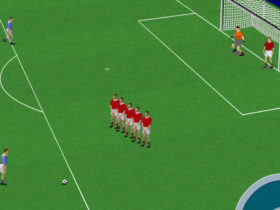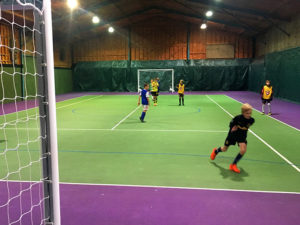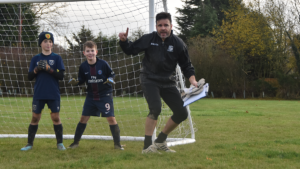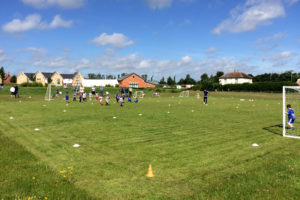Read the latest part of our guide to the UEFA B Coaching Course, written by JBFC head coach Jamie Bradbury. Day three was a case for the defence..
UEFA B Coaching Course – Day Three
The day began in the classroom as we looked back at tutor Colin Reid’s ‘playing out from the back’ pattern practice from the afternoon before.
The session started with no opposition for the team he was working with. It was likened to how the legendary coach Arrigo Sacchi would famously work with his teams, particularly AC Milan. The Italian would place flags around the pitch and arrange his team into a shape to defend each flag as if it were an attacker with the ball.
This particular UEFA B coaching course pattern practice, focusing on a team building up an attack from the goalkeeper’s possession, progressed as Colin gradually introduced opposition.
As a coach, I’d definitely try sessions like this and organise my team in this way, but it emphasises why you need to be coaching an appropriate team to be able to attempt it. Some players might just like to turn up to training and play games, so to have a group waiting to join in on the side may leave them bored.
Fortunately for me, my team is quite open to developing and growing and I also have other coaches to help keep the additional players occupied. It certainly gave me something to think about.
We then gathered in our tutor groups. Course Director Jon Gittens is our UEFA B coaching course tutor and we began to look towards our own practical sessions that we are to deliver over day four and five.
Jon explained that it was a chance for us to just show where we are at as coaches and to give him and the three other tutors – Colin, Ted Dale and Richard Carter – an idea of what we are like. He offered us some pointers to consider; session organisation, communication styles, presence, and said we could coach any practice we wanted. We had 25 minutes each to deliver our sessions.
I initially thought about a practice that I like doing with my club, a Level 2 session focused on passing and receiving, but also considered another favourite – an adaptation of a defending practice I’d seen Roy Hodgson use with the England Senior team at St. George’s Park. But I had the night to think on it and finalise my plan.
Ted then took centre stage and addressed the four tutor groups – 48 UEFA B coaching course candidates in total – on the Principles of Play. These are fundamental to the game, they are at its very heart, and all sessions should be linked to them.
At Level 2 you look at the basic principles; create, maintain, exploit space; deny, delay, restrict space, but here we explored them in more depth. Each principle (attacking and defending) has five components.
When in possession, the attacking team will want to create space using movement, dispersal, support, penetration and innovation. Their focus will be to retain possession, move forward into attacking positions and create goal-scoring opportunities.
A defending team will try to do the opposite to combat that and will deny space by delaying, creating depth, being compact, having cover and balance in their organisation and use control and restraint – patience. Their aim is to regain possession, be a compact defensive unit and limit opportunities for their opposition.
But with all those components, coaches and players need to know which one to apply at the right time. For example, penetration would be a team’s primary focus within the first six seconds of regaining possession, ie during the transition.
Following neatly on from this, Ted was the first of three practical sessions on the 3G that afternoon and looked at a small-sided game on defending. Again, I’ve also used The FA Coach’s App to draw up one of the other practices – Colin’s on pressing – which you can download below.
10 Principles of Defending
Small-sided game
Ted arranged his team in a small area next to the main pitch to demonstrate where the players should be working in the full practice, and they began by throwing the ball around. It allowed him to highlight some of the key messages of the session.
When progressing on to the pitch, an 8v8 game ensued as he coached one team who started with the ball. This allowed realism and the opportunity to work on his team from the moment they lost the ball – the transition between attack and defence.
One of the main points was what the player nearest the ball would do, and his decision would set the rest of the team in motion: Can he win the ball? If so, go and win it. If not, can he force the ball backwards. Ted spoke about ‘small victories’ across the pitch.
11 Pressing
Squad Practice – click to download pdf created with The FA Coach’s App
Colin’s practice was again made to look as real as possible and was similar to a small-sided game with an 8v8 and two target areas at either end.
He talked about the key points to defend against; a player, the ball, a space and the goal. The idea was to put pressure on the ball, block lines and provide depth.
So, the less pressure on the ball, the deeper the covering angle and the deeper the defence will need to be to avoid opening up space in behind. As pressure is applied to the ball, then the defence can move up.
12 Sliding and screening
Small-sided game
Richard’s practice continued on the defending team, an 8v8 game, and focused on the team’s movement in response to the position of the ball. He began by working on the starting positions of his team with the ball in different areas of the pitch.
He looked at pressing, when and where to concede possession, screening to prevent penetrative passes, securing the space behind and ahead of the back line, the distances of the supporting defenders and making play predictable.
And with the clock ticking swiftly towards 5.30pm, what was predictable was the conclusion of day three. But the day’s work wasn’t over – when I get home what session would I choose to plan for myself…
Check out the rest of our UEFA B coaching course guide here on FootballCommunion.com…
If you have any questions you can follow Jamie on Twitter @jamiebradbury.


































